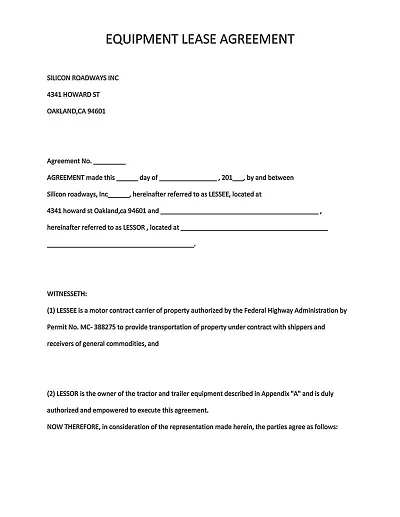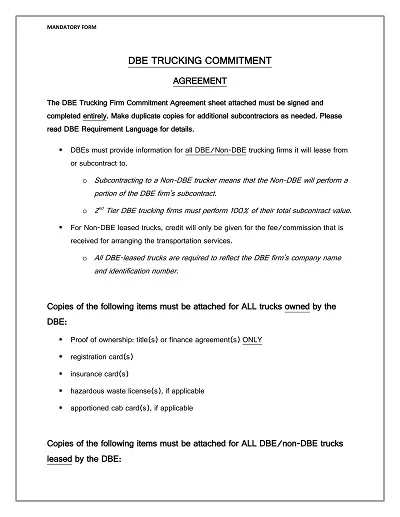25+ Free Simple Truck Lease Agreement Templates – PDF
Truck Lease Agreement Template is a document containing general legal provisions that may be legally changed by the parties as per their expectation of the outcome of the agreement between the lessor and the lessee. The legal environment of leases makes this template enforce contracts in the area and reduce ambiguity, especially on schedules of payments and maintenance. They showed that it acts as a roadmap for each other, and in case of any disagreement, it helps remove confusion in the relationship.
Contents show
The existence of regulations relating to the industry it operates in, insurance provisions, and mechanisms for disputing are some of the conditions and terms in the template. It serves an essential function within the trucking industry as it creates favorable conditions for a successful partnership. Using this agreement template can help mitigate risks and protect both parties by establishing clear terms that may prevent possible future conflict.
Download Free Simple Truck Lease Agreement Templates




Components of a Truck Lease Agreement
Here are some Components of a Truck Lease Agreement:
- Parties Involved: Among the basic aspects of thinking is the definition of the transaction participants: the lessor – the truck’s owner and the lessee – the legal entity or the person who received the car for a specific period. All parties need to clearly understand what each is expected to do because it helps outline the framework of a working agreement.
- Duration and Termination: State the period for the lease and under what circumstances the agreement may be terminated. This clarification on these areas avoids ambiguity and means that the period towards the end of the lease period runs smoothly.
- Payment Terms: Describe the payment schedule and policy concerning rental charges, deposits, and other extra charges to be levied. This section needs to be very comprehensive so that there is no room for debate in the future regarding the implementation of the agreement.
- Maintenance Responsibilities: Identify the parties legally bound to perform maintenance and repair work. These terms are significant and often become contentious issues when not well-defined.




Benefits of Using a Truck Lease Agreement
The benefits of using a truck lease agreement template are numerous, and here are just a few:
Flexibility for Businesses
This is especially important for businesses that require using materials for a short time or in a certain period where they cannot commit themselves to purchasing indefinitely. As with shippers with varying demands for transportation services, it is a strategic move.
Cost-Effective Option
They do not require the client to front cash as they do when they want to purchase the truck themselves. This appears to be an affordable strategy, especially for the businessman with minimal capital to invest in his company.
Access to the Latest Truck Models
The transport industry involves using technology and having a set of rules and regulations that are likely to change occasionally. Leasing covers all aspects of coming to business with optimized models and ensuring compliance with legal requirements.




How to Draft a Truck Lease Agreement
When drafting a truck lease agreement template, it is essential to keep the following considerations in mind:
- Seek Legal Advice: Due to legal issues that are likely in the contract, consulting a legal practitioner ensures that it meets all the requirements in compliance with the law and upholds the interests of the two parties.
- Clearly Define Terms and Conditions: Making your terms and conditions specific in every little detail is wise. It helps to agree very clearly about payment, caring, and other aspects in your contract that may state what happens if one party fails to deliver.
- Include Details About Maintenance and Repairs: A good example is that there must be a comprehensive maintenance section to observe and respond to the needs of the building. One is to outline the daily, weekly, or monthly chores, repair processes, and costs and how they will be addressed.




Tips for Negotiating a Truck Lease Agreement
When negotiating a truck lease agreement, here are some tips to keep in mind:
Understand Your Business Needs
What makes your business tick must be made clear before entering into any negotiations. It allows you to negotiate terms that, to an extent, fit your operational needs since such information is key to decision-making, whereby you determine what works best for your business.
Negotiate Favorable Terms
Set acceptable profits and accept the prices and other terms that will be more appropriate for your business. This entails operational relationship finance-related aspects and conditions that can foster efficiency.
Clarify Maintenance and Insurance Costs
When reaching agreements, explain the terms of how and when the cost of maintenance and insurance will be paid. These aspects enable avoidance of such shocks and simultaneously, foster clear and mutual cooperation.
Crafting a Comprehensive Truck Lease Agreement Template
Now that we have explained the notion, let us put it in the form of a template containing the mentioned essentials.
1. Introduction
- Parties Involved: In this case, the following shall be stated: The lessor: X This refers to the party that gives out the lease. The lessee: Y This party takes the lease from the lessor.
- Effective Date: In the lease agreement, it is important to state when the lease starts.
- Purpose: Can a summary of the lease and its main objective be provided?
2. Lease Terms and Conditions
- Duration: It is paramount to clarify the lease agreement’s duration and any options to further the lease term.
- Termination: Present circumstances under which either party can decide to part ways with the lease agreement.
3. Payment Terms
- Lease Rate: Set out the agreed rate for hiring the truck for lease at a, $\textit<(state the agreed amount)>. $
- Payment Frequency: This is a basic question that an expert is asked to answer before formulating recommendations: Who should make the payment, and by when?
- Late Payment Penalties: This aspect must spell out any consequences or penalties for delayed payment.
4. Maintenance and Repairs
- Responsibilities: Determine how often the turbine components are looked after and who should arrange for general maintenance and repairmen.
- Reporting: Explain procedures that must be followed in cases of formatting or damage and how the issues get rectified.
5. Insurance Requirements
- Type of Insurance: Give the type of insurance that must be provided.
- Coverage Amount: This amount must be stated clearly and with great detail, evidencing the expected minimum coverage.
- Insurance Responsibilities: Outline the role of each purchasing agent in purchasing insurance and/or maintaining insurance for their department/ organization.

















